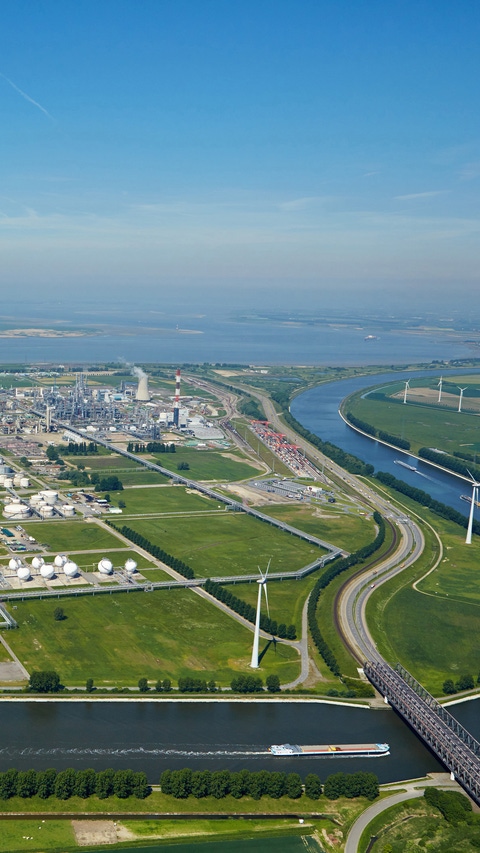BASF Antwerp
History
The 2000s: continued expansion and collaboration with partners
2022 | BASF is building a new world-scale production facility for acylethanolamines (AEOA) in Antwerp. After the planned start-up in 2024, BASF will see its annual global production capacity of acylethanolamines increase to more than 140,000 tons per year.
2021 | BASF and Vattenfall have signed a contract for the purchase of 49,5% of the offshore wind farm Hollandse Kust Zuid. From 2023, Holland Kust Zuid will provide the entire energy supply for the site in Antwerp.
2020 | BASF and Evides Industriewater sign a long-term partnership that includes the design and construction of a new demineralized water plant and the supply of the right amounts of feedwater.
2019 | BASF Antwerp joins forces with eight leading companies from the harbour area to investigate the technical and economic feasibility of CO2 infrastructure in the port.
BASF is significantly expanding its integrated complex for ethylene oxide and derivatives at their Verbund site in Antwerp.
2015 | BASF prepares to invest heavily in groundbreaking technology for superabsorbent polymers. The plant in Antwerp is the first one to be expanded and modified for manufacturing this innovative product SAVIVATM.
2014 | BASF celebrates its 50e anniversary in Antwerp with its (former) employees, neighbors and other stakeholders. BASF enters into a project with the City of Antwerp, "Elements for Talents". In this project the company commits to providing substantive and financial support for various training and education projects for youth during the next few years.
2012 | BASF decides to build an extraction facility for butadiene at the Antwerp site.
2011 | BASF sells its fertilizer activities to the Russian fertilizer manufacturer EuroChem. The European Commission gives BASF and INEOS the green light for the formation of the joint venture Styrolution. The Antwerp facilities that manufacture and ship styrenics are included in this joint venture. BASF will sell its shares to INEOS in 2014.
2009 | In March BASF begins operating a new terminal for inland shipping. That same month, the company begins construction on a multimodal road/railway terminal in collaboration with the Swiss train operator Hupac and Inter Ferry Boats (IFB), a subsidiary of the NMBS.
2006 | BASF invests € 1 billion in the Antwerp site. The program starts in 2006 and is completed in 2008.
1999 | Solvay and BASF merge their PVC and PVDC activities in the joint venture Solvin GmbH und Co. KG (75% Solvay N.V. Brussels, 25% BASF-owned).
The 80s and 90s: becoming a full-fledged Verbund site
1990 | A very significant investment in a world-class steam cracker is announced. This facility becomes the new operational heart of BASF Antwerp. Various other downstream facilities in the chain of production are added throughout the 90s: the polyisobutene, acrylic acid, superabsorber and propylene oxide facilities.
1989 | The BASF group announces the construction of an ammonia facility in Antwerp.
1987 | The activities in Antwerp are expanding. The MDI facility is expanded. A third nitric acid facility, a second hydrogen/CO facility and a second nitrobenzene and aniline facility are built in preparation.
1980 | BASF Antwerp begins operating its biological water purification facility. This makes BASF Antwerp one of the first companies in the port area to start using biological purification of industrial waste water.
The 70s: oil crisis as an opportunity for energy efficiency
1979 | The second oil shock leads to shrinking investment budgets. Several facilities are shut down temporarily or even permanently during the next few years. The lack of new investments motivates the company to make existing processes more energy-efficient.
1976 | BASF Antwerp expands its product line with smaller-scale facilities for speciality chemicals that are less affected by the economic climate at that time.
1975 | Despite the oil crisis, BASF decides to continue investing in a limited number of important opportunities, such as the construction of their first MDI facility. MDI is one of the main components of polyurethane foams, Capacity is rapidly expanded. This is followed by investments in facilities for speciality chemicals as well.
Our early years in the Golden Sixties
1967 | The first plants are built. They produce nitric acid, phosphoric acid and sulphuric acid, intermediates for the production of Nitrophoska, a synthetic fertilizer.
1965 | Construction on the new site in Antwerp begins in the fall. The plant is modelled on the headquarters in Ludwigshafen. The "Verbund" structure meant that the company put corporate sustainability into practice right from the start.
1964 | In 1964 BASF decides to build a new plant in Antwerp and allocates 200 million Deutsche Mark to this project. On 10 December 1964, BASF Antwerpen NV is officially formed as a BASF subsidiary.
Video: dive into BASF Antwerpen's history of more than 50 years in Antwerp.
